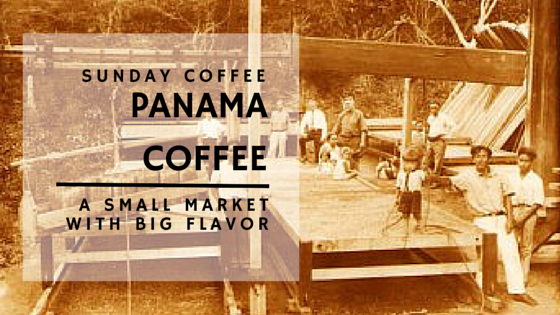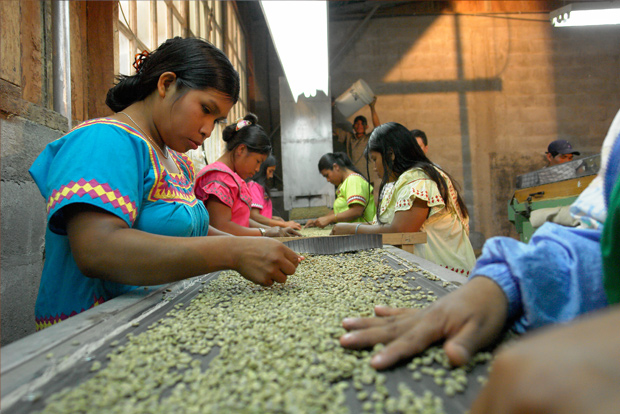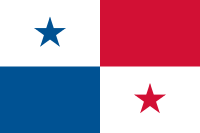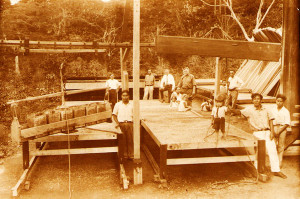
Have you ever experienced the wonderful coffees of Panama?
With over five different coffee varieties, this small strip of land connecting the North and South American continents has a lot to offer. Everything that coffee needs to be exceptional, can be found there. The highlands of Chiriqui, in western Panama, are known for their high nutrient soils, consistent rainfall, and perfect altitude to produce quality beans.

Ngobe-Bugle Coffee Farmers / Courtesy of Specialty Coffee Association of Panama
The History Of Coffee In Panama
 The first coffee plants to come to Panama were brought to the city of Boquete in the early 1800’s by an
The first coffee plants to come to Panama were brought to the city of Boquete in the early 1800’s by an
English sea captain. The plants would ultimately find their way to the Boquete valley, which became an ideal environment for coffee to grow. Even with such a promising beginning, the coffee industry for Panama remained stagnant, as cheaper, mass-produced coffees from other countries dominated the market. It’s really been in the last 20 years that Panama coffee has become competitive, as investors saw the value of the flavor varieties Panama coffee offered.
No doubt, the third wave (learn more about third wave coffee) movement in the United States contributed to this change. Under third wave, the flavor of coffee became a specific criteria for specialty coffee. The variety of micro-climates and harvesting methods between coffee farms within Panama, produces subtle variations in flavor. According to the Specialty Coffee Association of Panama (SCAP), the variations of quality and taste allow producers to classify their beans by micro lots. Buyers are now able to trace the origin of the coffee to the farm where it was harvested and know the method used in its processing.
Varieties of Panama Coffee
- Geisha (Coffea arabica var. geisha) – The Geisha coffee is easy to recognize because the
 cherries are longer, as if they’ve been stretched. Originally from Ethiopia, the Geisha variety found its way to Panama, by way of Costa Rica in 1963. It’s here in Panama that the Geisha gained its popularity and worldwide demand. Both the aroma and taste, are full of flowery and citrus notes with an expanded aftertaste. To learn more about Panama Geisha, read our review, Geisha Coffee: Living Up To the Hype.
cherries are longer, as if they’ve been stretched. Originally from Ethiopia, the Geisha variety found its way to Panama, by way of Costa Rica in 1963. It’s here in Panama that the Geisha gained its popularity and worldwide demand. Both the aroma and taste, are full of flowery and citrus notes with an expanded aftertaste. To learn more about Panama Geisha, read our review, Geisha Coffee: Living Up To the Hype. - Typica – One of the most common, from which many coffee variations are developed. The Typica is a tall tree with branches that grow at an angle, resembling a cone shape. The cup quality of Typica is high and is characterized by sweetness, cleanliness, and body.
- Bourbon – The cherry of the Bourbon coffee tree is small and dense and can mature into red, yellow and orange colors. The ideal altitude will be 3500 – 6500 ft. The cup quality is high and comparable to Typica.
- Caturra – The Caturra variety is labor intensive and requires a lot of care and consistent fertilization. You will find it thriving in lower altitudes of 1500 – 5500 ft. Quality does increase at higher altitudes, but the production decreases. Caturra is known for having a low to medium body.
- Catuai – Catuai is a coffee plant that works well in environments with strong winds because the cherries cling to its branches. Another variety that requires continual care but is known for its high yields. Catuai is also known for its high acidity.
Three Things That Make Panama Coffee Unique
Culture – The heritage of the coffee industry in Panama is centered around two native Panamanian tribes, the Ngobe and Bugle. For generations, the Ngobe-Bugle natives have been involved in every part of the coffee process. This experience has developed uniques sensibilities to harvest mature cherries at the optimal point.
Environment – The unique flavors and aroma’s of Panama’s coffee owes itself to the high altitudes of the mountains where it is grown. Higher elevations mean cooler temperatures, which slows the growth of the coffee. The slowed growth, as well as the consistent shade provided by the rain-forests, help produce the wonderful character of Panama coffee.
Farmers – The coffee farms found in Panama are worked by hand, with generations of skill going into each step of the harvesting and processing. Many of the farmers cup and grade their own coffee, allowing them to work directly with buyers on quality and pricing.
A Few Of The Coffee Farms In Panama
- Finca Deborah
 Casa Ruiz, S.A.
Casa Ruiz, S.A.- Cafe’ Kotowa
- Carmen Estate Coffee
- Don Pachi Estate
- Hacienda La Esmeralda
- La Mariana Estate
- Finca La Valentina
To learn more about Panama Coffee, check out these helpful resources,
Specialty Coffee Association of Panama
To purchase coffee from Panama, check out Panama Coffee Gold Reserve.